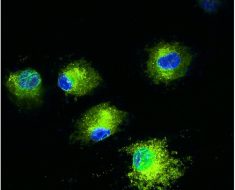
Arsenic is often listed as a carcinogen, which is a substance whose presence in a person’s environment can lead to the development of cancer.
However, some arsenic-based compounds have been used throughout history to treat various medical conditions.
One such compound — called arsenic trioxide (ATO) — is still used today, and it actually gained Food and Drug Administration (FDA) approval under the marketing name Trisenox in 2001.
Now, researchers from the Beth Israel Deaconess Medical Center (BIDMC) in Boston, MA, are investigating the potential of ATO in treating cancer.
Specifically, Drs. Kun Ping Lu, Xiao Zhen Zhou, and colleagues looked at how ATO in combination with another existing drug — all-trans retinoic acid (ATRA) — can be used to actually cure promyelocytic leukemia, which is a type of blood cancer.
The mechanisms through which ATO in combination with ATRA can help cure this type of leukemia have been unclear, but this study sheds light on how these substances act at the cellular level, suggesting that their interaction may be useful in treating other kinds of cancer, as well.
Their findings appear in the journal Nature Communications.

Blocking and destroying a key enzyme
The researchers worked with models of leukemia, breast, and liver cancer, and they were able to find that the ATO-ATRA combination destroyed an enzyme known as Pin1.
Pin1 plays a key role in regulating signaling networks in cancer; it activates over 40 proteins that feed cancer tumors, while also blocking over 20 proteins that would normally suppress tumor growth.

This enzyme is overactive in most types of cancer found in humans — particularly so in cancer stem cells, which drive tumor growth and can often be key to cancers’ resistance to traditional treatments.
In this study, the scientists observed that ATO binds to Pin1, blocking its action and eventually leading to the enzyme’s deterioration. At the same time, ATRA — which also binds to Pin1 and degrades it — facilitates and increases cells’ uptake of ATO.
This leads to the increased expression of a protein specific to cell membranes, which boosts the cells absorption of ATO.
When working with mice engineered not to express Pin1, the researchers also saw that the rodents were actually highly resistant to cancer.
These animals suffered no ill effects as a result of the blocked enzyme expression for about half of their lifespans, which suggests that targeting Pin1 at baseline can be a safe approach.
“Our discovery strongly suggests an exciting new possibility of adding [ATO] to existing therapies in treating triple-negative breast cancer and many other cancer types, especially when patients’ cancers are found to be Pin1-positive. This might significantly improve the outcomes of cancer treatment.”
Dr. Xiao Zhen Zhou

Future work to address shortcomings
Drs. Zhou, Lu, and colleagues emphasize that their new findings may lead to effective strategies for targeting Pin1, for which no inhibitors have so far been developed.
“It’s gratifying to see this combination of [ATRA] and [ATO] that my [laboratory] discovered to be curative in the treatment of acute promyelocytic leukemia translate into possible approaches for the treatment of other cancers,” explains Dr. Pier Paolo Pandolfi, of BIDMC, who first found that a combined ATO-ATRA treatment was able to cure that type of blood cancer.
“Indeed,” he adds, “it is interesting to speculate that this combination may even prove curative in other tumor types yet to be discovered.”
Still, the team notes one shortcoming of the ATO-ATRA combination treatment — namely, that ATRA has a very short half-life in humans.
“We and others have confirmed the ability of [ATRA] to inhibit Pin1 function in breast cancer, liver cancer, and acute myeloid leukemia, as well as in lupus and asthma,” notes Dr. Lu.
To this, he adds the warning, “[H]owever, clinical uses of [ATRA], especially in solid tumors, have been severely limited by its very short half-life of 45 minutes in humans.”
The authors nevertheless hope that the results of the study will provide sufficient motivation for future studies to focus on developing longer-lived, more resilient ATRA.
“Our results stimulate the development of longer half-life [ATRA] to combine with [ATO] or other more potent Pin1 inhibitors because they may offer a promising new approach to fighting a broad range of cancers without general toxicity, as proven in curing [acute promyelocytic leukemia],” says Dr. Lu.
Source: Read Full Article





